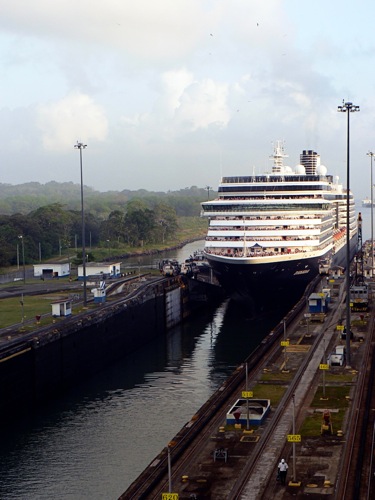
Nearing its 100th birthday in 2014, the Panama Canal, one of the engineering wonders of the 20th century, still elicits awe, wonder and curiosity.
“It’s an engineering marvel; it’s just incredible,” said Linda Holm, coordinator of Texas Travelers at the Texas First Bank in Texas City, Texas. “It’s a wonderful experience you need to do sometime in your life.”
Holm’s group had that wonderful experience in January on a Panama Canal cruise aboard Princess Cruise’s Island Princess. They joined eight other bank clubs that purchased the cruise through Islands in the Sun Cruises and Tours.
Although the canal, which is a series of locks and the huge man-made Lake Gatun that allow ships to pass between the Atlantic and Pacific oceans across the Isthmus of Panama, was the headliner for the cruise, the 1,970-passenger Island Princess also made stops in Aruba, Colombia, Costa Rica and Jamaica on a roundtrip from Fort Lauderdale, Florida.
To account for possible travel delays with more than 250 people traveling with them, Islands in the Sun owners Susan and Russ Rosenberry brought the groups in a day early.
On the morning the cruise departed, the groups took airboat tours of the Everglades.
Lois, a step-on guide with Holm’s group, pointed out that most of the Everglades, which stretches for 100 miles through southern Florida, is a river.
“Most people think it is a swamp, but it really is a river of grass,” she said. The 1.5 million-acre Everglades National Park is the third-largest national park.
After a morning in the Everglades, the groups met up Port Everglades in Fort Lauderdale and boarded the ship for its late-afternoon departure.
Aruba
After two full days crossing the Old Bahama Channel and passing the coastline of Cuba, the Island Princess arrived at its first stop, the Caribbean resort island of Aruba, just seven miles from the shore of Venezuela.
Aruba, independent since 1986, still retains much Dutch influence from its time as part of the Netherlands Antilles. That influence is especially evident in the port city and capital Oranjestad, where the Island Princess docked.
Rainbow-colored yellow, blue and red buildings with distinctive Dutch-style stepped rooflines line the streets and are filled with shops that offer a wide range of items from typical touristy souvenirs to quality jewelry and clothing.
Holm opted to browse the area near the dock instead of heading for the island’s famous white-sand beaches. “Right after you get off the pier, you are in the midst of a bunch of shops,” said Holm. “There are bright-colored buildings that are a reminder of the colonial atmosphere. The thing I liked about the market area: It was so colorful. Every building had an interesting roofline.”
Cecila McCamish’s group from the Funchasers Travel Club at Security State Bank in Littlefield, Texas, headed to the beach.
“Most everyone felt like Aruba was the most picturesque stop on the trip with its white, sandy beaches and resort feel,” she said. “Personally, if my husband and I were going back to any of the ports for an extended stay, Aruba would be our choice.”
The most developed part of the beach is the two-mile stretch along the west coast at Palm Beach, which is lined with high-rise hotels, restaurants, shops and water-related activities. Beaches on the other side of the island are more secluded and less developed.
An interesting contrast between Aruba’s white-sand beaches and turquoise water is its desertlike interior with cactus and windswept divi-divi trees; the area can be visited on some of the several guided shore excursions the Island Princess offers.
Other excursions showcase the island’s other natural attractions, such as Natural Bridge and Baby Natural Bridge and the Ayo and Casibari rock formations, along with man-made attractions such as the California Lighthouse and a butterfly farm.
Cartagena, Colombia
The Island Princess left Aruba in the early afternoon and after an all-night cruise, arrived at Cartagena Sunday morning. Although Cartagena is a bustling modern city with many tall buildings on its skyline, it retains many reminders of when it was the major port of the Spanish colonial empire in South America.
One of the most prominent of those reminders is the Castillo de San Felipe de Barajas, the huge 17th-century fortress that overlooks the city and harbor.
“There is a lot of climbing and walking, but it was really interesting,” said Holm. “It is no wonder the city was impenetrable, it is a huge, massive structure right there in the harbor; it could control access in and out.
“It’s all still authentic, and there is a beautiful view from the top looking out over the city and harbor.”
Holm’s guided shore excursion also took her group to Las Bóvedas, former military dungeons that now house boutiques and tourist shops, and on a walking tour of the walled old city, which is a UNESCO World Heritage site.
“There were street artists, flower boxes hanging over narrow streets and local people selling handmade goods,” she said. “An old man was painting with the heel of his hands and his fingers. He took paint, dropped it on and smeared it, but ended up with the most beautiful little pictures.
“It’s really cool to buy local art. You know that what you bought was from the guy who made it.”
Cartagena also has an impressive 410-year-old cathedral, a 400-year-old monastery with panoramic views of the city, a gold museum and a palace museum with pre-Columbian, colonial and independence-era art.









